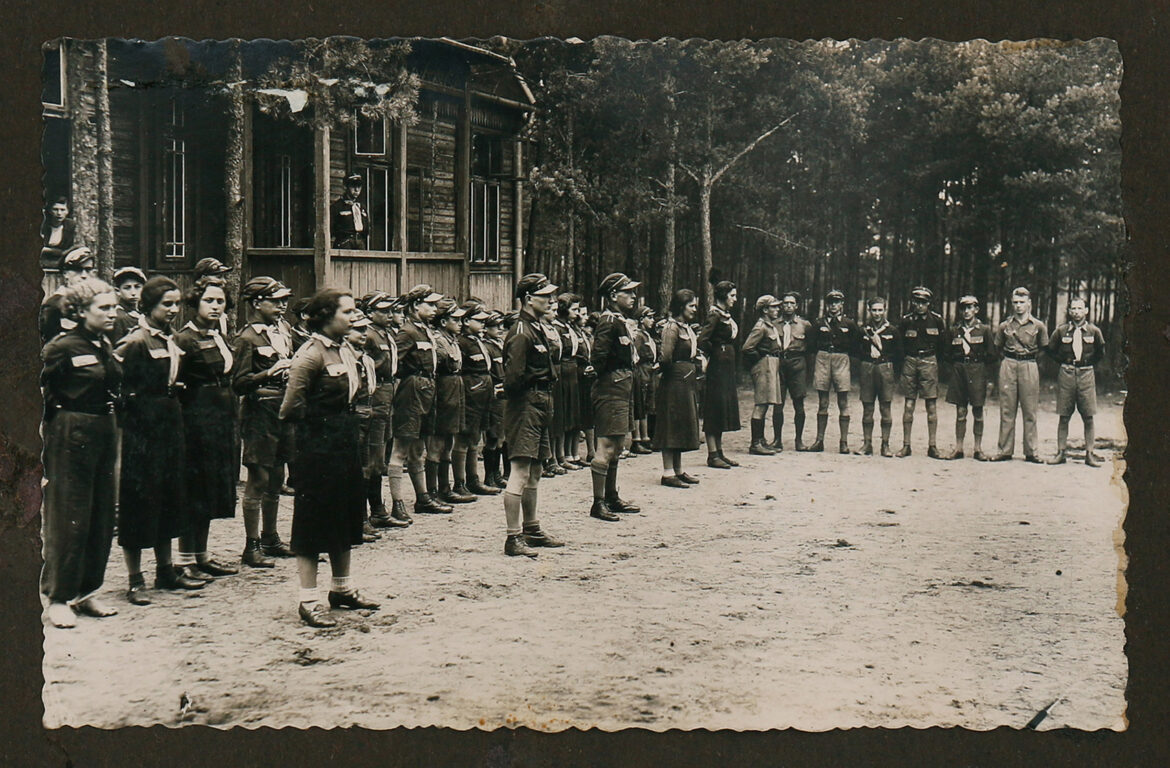In the spring of 1939, Polish specialists, and military officers in Andrychów, near Wadowice, trained Jewish revisionists, drawn from the youth organisation, Betar, who later became the command cadre and brave fighters of the Irgun. People with no military training became conspirators and soldiers who could fight for Israel.
In 1923, a new organisation of Zionist youth, Betar, was founded in Riga, stemming from Jewish nationalist milieux, led by the charismatic activist Vladimir Jabotinsky. Unlike the left-wing Haganah, which attempted to achieve its goals through diplomacy, the revisionists were in favour of undertaking an independent armed struggle to create a Jewish state. In 1934 Betar had around 70,000 members, with 40,000 of its members residing in interwar Poland, and Warsaw soon became the headquarters of the organisation’s leadership. In 1939, out of a total of 100,000 Betar members, about 75% of the members lived in Poland.
In the Jewish young revisionist circles, there was a fashion for physical activity. Betar organised sports activities, gymnastics and boxing clubs, and team sports were played. Vocational education, such as learning agriculture or crafts, was also an important element. In addition to formation classes, shaping the characters of Jewish youth in the spirit of patriotism and putting the interest of the whole nation above the individualism and egoism of individuals, paramilitary training was undertaken.
Betar’s programme documents left no doubt: “Betar stands steadfastly on the legionary position: it requires its members and even all Jewish youth to train in the technique of using weapons”. Betar therefore looked for places and ways to prepare for the fight to obtain a Jewish state. As a result, contacts were made with Italians who had trained revisionist youth in Civitta Vecchia in the 1930s. A course for pilots and a naval school were also conducted. But the Jewish revisionists found the greatest support for the idea of military training among the authorities of the Second Polish Republic, who saw the needs of the Jewish nationalists and decided from the 1930s to actively, albeit secretly from the British, support them.
Older youths originating from Betar, called kshishim, became members of the V. Jabotinsky Brith-Hachayal organisation on reaching the age of eighteen, for whom military training was provided. The support given to Betar and the revisionists by the Polish authorities took place on many levels. It was the only national minority organisation in pre-war Poland that was trained by the Polish Army.
During military training in pre-war Poland, young Jews learned shooting, hand-to-hand combat, construction of explosives, principles of tactics and combat strategy, guerrilla warfare, conspiracy and diversion. The government of the Second Polish Republic simultaneously acted to enlarge the Jewish territory with the Negev desert. In addition, the Polish authorities provided substantial funds to Jewish nationalists who wanted to enable thousands of Polish Jews to make their way to the Middle East. This was due to the overpopulation of towns in pre-war Poland and Jewish ambitions to establish an independent state in Palestine. As Wiktor Drymmer, a Polish diplomat who supported this action, recalled: “In 1938, I convened a great conference to which I invited all Jewish organisations. It was unanimously agreed that various ways must be sought for the Jewish emigration that was necessary.”
The cooperation of the Jewish right-wingers with the Polish Sanation government was also due to the memory of their joint fight in the Polish Legions during the First World War, which caused some Polish Jews, inspired by the Polish struggle for independence, to move to the militant-liberation positions and to be supporters of the struggle for Israel’s independence. The Polish Military Organisation and the Polish Legions became a model for Jabotinsky and Abraham Stern to create their own militant structures, and one of the most revered figures for them became Jozef Pilsudski, whose funeral in 1935 was massively attended by Betar members. After the Marshal’s death, a special Jewish delegation brought soil from Tel Haj in an urn and buried it solemnly in J. Piłsudski’s mound in Kraków. These sympathies were not only due to the similarity of the Polish Legion idea to that of the Jewish Legion, or Piłsudski’s benevolent attitude to Jews, but also – as revisionists pointed out – due to the merits of the Polish authorities for the eventual restoration of the Jewish state.
The authorities of the Second Republic supported the Jewish revisionists unofficially, in secret from Great Britain, with which Poland had concluded an alliance in 1939. The Poles donated a large amount of arms and ammunition to the Zionist-Revisionists. Some of the armaments were transported to Palestine. Unfortunately, due to the outbreak of the Second World War, it was not possible to export everything to the Middle East and the remaining batch of arms and ammunition was placed in a hidden depot in Warsaw. During the siege of the country’s capital by the Germans, Lilia Strasman, who belonged to the Irgun, passed on information about the existence of these weapons to General Walerian Czuma, who commanded the defence of Warsaw.
The skills learned from training in Poland were used by some Jewish nationalists when they fought in the Warsaw Ghetto uprising of 1943, taking up arms against the German occupiers as part of the Jewish Military Union. Jewish revisionists can be credited with creating a new model of the indomitable and fighting Jew – for his state and independence. The ideal of fighting for an independent Jewish state instilled in the youth even before the Second World War played a not considerable role in the construction of the new, strong state of Israel.





